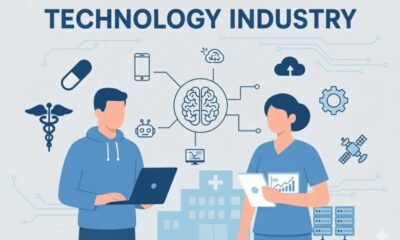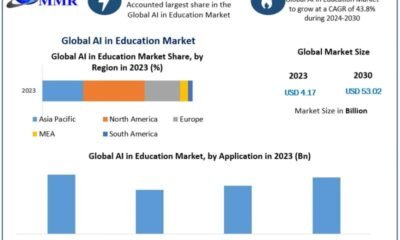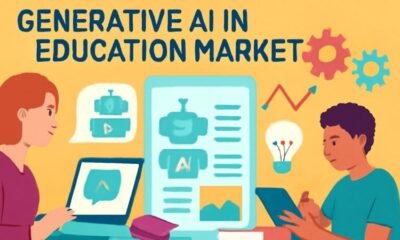AI Insights
Legal Artificial intelligence (AI) Software Market Set

The Legal Artificial Intelligence (AI) Software Market was valued at USD 1.5 billion in 2024 and is anticipated to grow to approximately USD 5.3 billion by 2033, with a CAGR of about 16.3% from 2025 to 2033.
Legal Artificial intelligence (AI) Software Market Overview
The Legal AI Software Market is rapidly expanding as law firms, corporate legal departments, and regulatory bodies adopt AI-powered tools to automate and enhance legal workflows. Key applications include contract review and contract lifecycle management, legal research and analytics, compliance and risk management, and document drafting and review. Advances in natural language processing, machine learning, and generative AI are enabling more accurate, efficient, and cost-effective outcomes, especially in document-heavy processes. The drive towards reducing legal costs, increasing speed, and minimizing human error is pushing wider adoption of solutions and services in this domain. While North America currently leads the market in both usage and revenue, regions such as Europe and Asia-Pacific are catching up fast thanks to technology diffusion and regulatory support. Overall, the market is poised for solid growth through 2033, underpinned by continuous innovation, increasing investment, and evolving legal technology landscapes.
Request a sample copy of this report at: https://www.omrglobal.com/request-sample/legal-ai-software-market
Advantages of requesting a Sample Copy of the Report:
1) To understand how our report can bring a difference to your business strategy
2) To understand the analysis and growth rate in your region
3) Graphical introduction of global as well as the regional analysis
4) Know the top key players in the market with their revenue analysis
5) SWOT analysis, PEST analysis, and Porter’s five force analysis
The report further explores the key business players along with their in-depth profiling
Thomson Reuters, IBM Corporation, ROSS Intelligence, Luminance Technologies, Casetext Inc., LexisNexis, Kira Systems, LawGeex, Everlaw, and Klarity.
Legal Artificial intelligence (AI) Software Market Segments:
🔹 By Component
• Solutions (Contract Analytics, Document Review, Legal Research, Compliance, e-Discovery, Case Prediction)
• Services (Consulting, Implementation, Training & Support, Managed Services)
🔹 By Deployment Mode
• Cloud-Based
• On-Premises
🔹 By Technology
• Machine Learning (ML)
• Natural Language Processing (NLP)
• Deep Learning & Predictive Analytics
• Generative AI
🔹 By Application
• Contract Review & Management
• Legal Research & Analytics
• Compliance & Risk Management
• Document Drafting & Automation
• Intellectual Property (IP) Management
• Litigation Support
🔹 By End-User
• Law Firms
• Corporate Legal Departments
• Government & Regulatory Bodies
• Others (Legal Process Outsourcing Firms, Academic Institutions)
Report Drivers & Trends Analysis:
The report also discusses the factors driving and restraining market growth, as well as their specific impact on demand over the forecast period. Also highlighted in this report are growth factors, developments, trends, challenges, limitations, and growth opportunities. This section highlights emerging Legal Artificial intelligence (AI) Software Market trends and changing dynamics. Furthermore, the study provides a forward-looking perspective on various factors that are expected to boost the market’s overall growth.
Competitive Landscape Analysis:
In any market research analysis, the main field is competition. This section of the report provides a competitive scenario and portfolio of the Legal Artificial intelligence (AI) Software Market’s key players. Major and emerging market players are closely examined in terms of market share, gross margin, product portfolio, production, revenue, sales growth, and other significant factors. Furthermore, this information will assist players in studying critical strategies employed by market leaders in order to plan counterstrategies to gain a competitive advantage in the market.
Regional Outlook:
The following section of the report offers valuable insights into different regions and the key players operating within each of them. To assess the growth of a specific region or country, economic, social, environmental, technological, and political factors have been carefully considered. The section also provides readers with revenue and sales data for each region and country, gathered through comprehensive research. This information is intended to assist readers in determining the potential value of an investment in a particular region.
» North America (U.S., Canada, Mexico)
» Europe (Germany, U.K., France, Italy, Russia, Spain, Rest of Europe)
» Asia-Pacific (China, India, Japan, Singapore, Australia, New Zealand, Rest of APAC)
» South America (Brazil, Argentina, Rest of SA)
» Middle East & Africa (Turkey, Saudi Arabia, Iran, UAE, Africa, Rest of MEA)
If you have any special requirements, Request customization: https://www.omrglobal.com/report-customization/legal-ai-software-market
Key Benefits for Stakeholders:
⏩ The study represents a quantitative analysis of the present Legal Artificial intelligence (AI) Software Market trends, estimations, and dynamics of the market size from 2025 to 2032 to determine the most promising opportunities.
⏩ Porter’s five forces study emphasizes the importance of buyers and suppliers in assisting stakeholders to make profitable business decisions and expand their supplier-buyer network.
⏩ In-depth analysis, as well as the market size and segmentation, help you identify current Legal Artificial intelligence (AI) Software Market opportunities.
⏩ The largest countries in each region are mapped according to their revenue contribution to the market.
⏩ The Legal Artificial intelligence (AI) Software Market research report gives a thorough analysis of the current status of the Legal Artificial intelligence (AI) Software Market’s major players.
Key questions answered in the report:
➧ What will the market development pace of the Legal Artificial intelligence (AI) Software Market?
➧ What are the key factors driving the Legal Artificial intelligence (AI) Software Market?
➧ Who are the key manufacturers in the market space?
➧ What are the market openings, market hazards,s and market outline of the Legal Artificial intelligence (AI) Software Market?
➧ What are the sales, revenue, and price analysis of the top manufacturers of the Legal Artificial intelligence (AI) Software Market?
➧ Who are the distributors, traders, and dealers of Legal Artificial intelligence (AI) Software Market?
➧ What are the market opportunities and threats faced by the vendors in the Legal Artificial intelligence (AI) Software Market?
➧ What are deals, income, and value examination by types and utilizations of the Legal Artificial intelligence (AI) Software Market?
➧ What are deals, income, and value examination by areas of enterprises in the Legal Artificial intelligence (AI) Software Market?
Purchase Now Up to 25% Discount on This Premium Report: https://www.omrglobal.com/buy-now/legal-ai-software-market
Reasons To Buy The Legal Artificial intelligence (AI) Software Market Report:
➼ In-depth analysis of the market on the global and regional levels.
➼ Major changes in market dynamics and competitive landscape.
➼ Segmentation on the basis of type, application, geography, and others.
➼ Historical and future market research in terms of size, share growth, volume, and sales.
➼ Major changes and assessment in market dynamics and developments.
➼ Emerging key segments and regions
➼ Key business strategies by major market players and their key methods
Contact Us:
Mr. Anurag Tiwari
Email: anurag@omrglobal.com
Contact no: +91 780-304-0404
Website: www.omrglobal.com
Follow Us: LinkedIn | Twitter
About Orion Market Research
Orion Market Research (OMR) is a market research and consulting company known for its crisp and concise reports. The company is equipped with an experienced team of analysts and consultants. OMR offers quality syndicated research reports, customized research reports, consulting and other research-based services. The company also offers Digital Marketing services through its subsidiary OMR Digital and Software development and Consulting Services through another subsidiary Encanto Technologies.
This release was published on openPR.
AI Insights
Companies Rehire Human Workers to Fix Artificial Intelligence Generated Content After Mass Layoffs

| IN A NUTSHELL |
|
The integration of artificial intelligence (AI) into workplaces has become a prevalent trend, often at the expense of human employees. This shift, while aiming to optimize efficiency and cut costs, has exposed the limitations of relying solely on AI. As companies increasingly replace human roles with AI, they encounter unforeseen challenges that highlight the irreplaceable value of human expertise. The journey reveals the complex dynamics between technology adoption and workforce sustainability, raising important questions about the future of work and the role of AI in it.
AI’s Shortcomings Lead to Reemployment
While AI promises to revolutionize industries by automating tasks, its execution often falls short, leading companies to reconsider their human workforce. AI-generated outputs frequently lack the nuance and precision that human creativity and expertise bring. For instance, textual content may appear repetitive, designs might lack clarity, and AI-generated code could result in unstable applications. These deficiencies compel businesses to turn back to the very employees they had previously let go.
Lisa Carstens, an independent illustrator and designer, experienced firsthand the limitations of AI. Based in Spain, Carstens found herself rehired to fix AI-generated visuals that were, at best, superficially appealing and, at worst, unusable. She noted that many companies assumed AI could operate without human intervention, only to realize the opposite.
“There are people who understand AI’s imperfections and those who become frustrated when it doesn’t perform as expected,” Carstens explains, highlighting the delicate balance freelancers must maintain when rectifying AI’s mistakes.
The Emergence of a New Freelance Economy
AI has inadvertently given rise to a new type of freelance work focused on improving AI-generated content. Developers like Harsh Kumar, based in India, have seen a resurgence in demand for their skills as AI’s limitations become apparent. Clients who invested heavily in AI coding tools often found the results to be unsatisfactory, leading them to seek human expertise to salvage projects.
Kumar echoes the sentiment that AI can enhance productivity but cannot entirely replace human input. “Humans will remain essential for long-term projects,” he asserts, emphasizing that AI, created by humans, still requires human oversight. While work is plentiful, the nature of assignments has evolved, with a focus on refining and iterating upon AI’s initial attempts at content creation.
The Challenges of Human-AI Collaboration
The dynamic between AI and human workers is not without its challenges. While companies that over-relied on AI often seek to rehire their former employees, they also attempt to reduce compensation for these roles. The justification is that the work now involves refining existing AI-generated content rather than creating it from scratch.
This shift highlights a more integrated human-machine collaboration where both entities contribute uniquely to the final product. However, it also raises questions about fair compensation and the value of human expertise in a world increasingly influenced by AI. As companies attempt to balance cost-cutting with quality assurance, the debate over appropriate remuneration for freelance revisions of AI work continues.
AI in the Workplace: A Double-Edged Sword
While AI offers numerous advantages, such as increased efficiency and cost savings, it also presents significant challenges. Businesses must navigate the delicate balance between adopting AI technologies and maintaining a skilled human workforce. The experiences of freelancers like Carstens and Kumar underline the necessity of human oversight in ensuring AI-generated content meets industry standards.
As AI continues to evolve, companies must critically assess its role in their operations. The initial allure of AI-driven cost reductions must be weighed against the potential for subpar results and the subsequent need for human intervention. This ongoing evaluation highlights the importance of strategic planning in technology adoption, ensuring that businesses maximize AI’s benefits without compromising quality.
As AI becomes further entrenched in workplaces, companies must decide how best to leverage technology while valuing human contributions. The need for skilled professionals to enhance AI outputs underscores the irreplaceable nature of human expertise. Will businesses find a sustainable model that harmonizes technological advancements with human creativity and skill, or will the pendulum swing back toward a more human-centric approach?
This article is based on verified sources and supported by editorial technologies.
Did you like it? 4.5/5 (24)
AI Insights
Susan B. Anthony House to offer artificial intelligence ASL interpreting for guests

The story is known to many.
“News hit, you know?” Hughes begins, recounting the history recited by many a docent over the years. “The 15 women in Rochester who had voted in the election in November of 1872 were all indicted. They had gathered together here, at this house, on that morning, election morning, and they’d walked out West Main Street.”
But while the National Susan B. Anthony Museum and House is something of a Mecca for some visitors, and a regular field trip for area school children, all this time, a segment of the population has been left out. Rochester is home to one of — if not the —largest deaf populations per capita in the world.
That is why the museum is turning to Sign-Speak, an emerging, locally developed artificial intelligence platform providing on-demand speech to sign, sign to text and speech to text interpretation.
Scanning a QR code with their phones to access the platform, deaf visitors soon will be able to take in Hughes’ words: “They had registered before using the 14th Amendment, which said everyone who is born in this country is a citizen. And the women were turning that around to say, ‘therefore, women are citizens,’ and demanding a right of citizenship,” she concludes, “which is voting.”
Adopting the new technology will help make the museum more accessible. But it also fits with the National Susan B. Anthony Museum and House’s mission to open up conversations, Hughes said, and move those conversations forward from 1872 to present day. Ideally, with as many perspectives as possible. And this is a particularly important time to do so, she added.
Part of the National Susan B. Anthony Museum and House’s mission is to open up conversations, Hughes said, and move those conversations forward from 1872 to present day. Ideally, with as many perspectives as possible — which is where a new partnership with Sign-Speak enters the room.
“We’re in a cycle now where the same questions have come back at us again (from Anthony’s time) about humanity, about people within the borders of the United States: What civil rights do they have? Who gets to participate in systems of justice? Does the government have freedom to limit your civil rights or your actions?” Hughes said. “What’s fair and what’s just, and how do we determine that?”
Sign-Speak, an emerging artificial intelligence platform based in Rochester that provides on-demand American Sign Language interpretation, may expand that opportunity to more visitors who are deaf and hard of hearing.
Nikolas Kelly, the deaf owner and chief product officer of Sign-Speak, said the partnership marks the first collaboration with a museum, and it’s just one of many possible uses for the tool.
“We do have voice recognition and closed captioning, but we also have sign language recognition, where you can sign into it to reply back, and then we also have an avatar, and that’s sort of like a signing person,” Kelly said. “And lastly, we do also have VRI, video remote interpreting, and that’s if a deaf person feels like they need a human for whatever situation to interpret for them.”
Kelly said he got the idea to create the digital tool when he was a student at the National Technical Institute for the Deaf at Rochester Institute of Technology.
“I had noticed at that time that voice recognition technology had propagated, become ubiquitous, but no sign language technology existed that allowed me to express myself in my preferred language of sign language, at any time, to communicate with hearing people,” he said.
The vision is to expand accessibility and independence, particularly when last-minute interpretation is needed and not available. Along the way, and throughout development so far, he said the Deaf community has been involved.
“Anywhere where AI is used, for example, for application development for disabled communities, I think that it’s important to emphasize inclusion of members of that community, of that disabled community, in the development process,” Kelly said.
Museum staff are scheduled to be trained on Sign-Speak next Wednesday, with the roll out of the platform for the museum taking place shortly after.
Below is a transcript of a radio broadcasted story:
HOST: “A local museum and start up are partnering to provide on-demand artificial intelligence American Sign Language interpretation for visitors. From WXXI’s Inclusion Desk, reporter Noelle Evans caught up with a leader at the company Sign-Speak about it.”
NIKOLAS KELLY: “There’s some situations where you can’t get an interpreter right away. So as deaf people, we’re often stuck.”
NOELLE EVANS: “That’s Niko Kelly speaking through an interpreter. He is the Chief Product Officer at Sign-Speak in Rochester. The company is teaming up with the National Susan B Anthony Museum and House to provide on-demand interpretation using an AI platform he and his team have been developing.”
KELLY: “We do have voice recognition and closed captioning, but we also have sign language recognition, where you can sign into it to reply back, and then we also have an avatar, and that’s sort of like a signing person. … And lastly, we do also have VRI, video remote interpreting, and that’s if a deaf person feels like they need a human for whatever situation to interpret for them.”
EVANS: “Kelly says he got the idea when he was a student at the National Technical Institute for the Deaf.”
KELLY: “I had noticed at that time that voice recognition technology had propagated, become ubiquitous, but no sign language technology existed that allowed me to express myself in my preferred language of sign language, at any time, to communicate with hearing people.”
EVANS: “He says this tool is a way to bridge that gap. The Susan B Anthony House is expected to roll out Sign-Speak for guests in the coming weeks. Noelle Evans, WXXI News.”
AI Insights
Teams That Prioritize Either Learning or Performance Perform Better

In today’s fast-moving work environment, organizations expect teams to do everything at once: perform flawlessly in the moment and constantly improve for the future. But is it wise to ask teams to chase both performance and learning outcomes at the same time?
-

 Business2 weeks ago
Business2 weeks agoThe Guardian view on Trump and the Fed: independence is no substitute for accountability | Editorial
-
Tools & Platforms1 month ago
Building Trust in Military AI Starts with Opening the Black Box – War on the Rocks
-

 Ethics & Policy2 months ago
Ethics & Policy2 months agoSDAIA Supports Saudi Arabia’s Leadership in Shaping Global AI Ethics, Policy, and Research – وكالة الأنباء السعودية
-

 Events & Conferences4 months ago
Events & Conferences4 months agoJourney to 1000 models: Scaling Instagram’s recommendation system
-

 Jobs & Careers2 months ago
Jobs & Careers2 months agoMumbai-based Perplexity Alternative Has 60k+ Users Without Funding
-

 Podcasts & Talks2 months ago
Podcasts & Talks2 months agoHappy 4th of July! 🎆 Made with Veo 3 in Gemini
-

 Education2 months ago
Education2 months agoMacron says UK and France have duty to tackle illegal migration ‘with humanity, solidarity and firmness’ – UK politics live | Politics
-

 Education2 months ago
Education2 months agoVEX Robotics launches AI-powered classroom robotics system
-

 Funding & Business2 months ago
Funding & Business2 months agoKayak and Expedia race to build AI travel agents that turn social posts into itineraries
-

 Podcasts & Talks2 months ago
Podcasts & Talks2 months agoOpenAI 🤝 @teamganassi



















